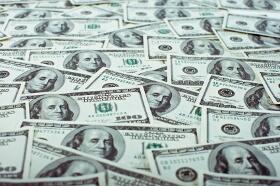The US dollar demonstrated exceptional performance in 2014. Can the greenback maintain its amazing rally in 2015 or correction is in order?
Fundamentally, the dollar has a strong bullish case in the form of expected monetary tightening from the Federal Reserve. Consequently, it leaves the US currency vulnerable to any changes of the Fedâs stance. Still, the monetary policy outlook should drive the greenback higher though some might argue that the factor is already priced in and may have muted impact in the future.
Talking about monetary policy, divergence between policies of various central banks should affect the performance of the dollar against different currencies. In particular, easing bias of the European Central Bank and the Bank of Japan should help the dollar to maintain an edge on the euro and the yen.
Turning away from central banks, another important consideration is the market sentiment. The dollar, being considered a safe currency, usually profits from fear and risk aversion. Such feelings were abound by the end of 2014 as the drop of crude oil prices dragged down riskier assets, including many currencies. Geopolitical tensions between Russia and the Western countries also played part in the greenbackâs rally. Depending on how events will unfold in 2015, they can have beneficial or detrimental impact on the US currencyâs performance. Most experts believe that oil prices bottomed out and should not fall further. Yet without a major rally low energy prices are likely to continue spoiling tradersâ mood.
Are there any negative factors that may affect the dollar? In fact, the bullish outlook of most market participants is in its own way a bad sign. Some specialists argue that it is unwise to join the herd as it is too late to enter the market when everyone runs in one direction. It even may be prudent to think about going in the opposite direction as market rarely go in one direction for long without reversing at least temporarily.
Saying that, it is important to note that the majority of market analysts are still bullish on the dollar though they think that correction is likely to happen sometime in 2015. The problem is in predicting exact timing of such correction. Some specialists think that that it will happen in the first half of the year, and the currency will resume its rally in the second. Others argue that the dollar will continue to rise in the first half, falling in the second.
The Bank of Nova Scotia said:
The collapse in oil prices has had a significant impact on global economic and financial market conditions. The USD is expected to appreciate with support from both fundamentals and flows. The financial market implications of the oil price shock will likely be a near-term stimulant for the USD.
The bank made following predictions for dollar currency pairs by the end of 2015: EUR/USD falls to 1.13, USD/JPY rises to 126, GBP/USD hangs near 1.51, USD/CAD advances to 1.20, and AUD/USD drops to 0.78.
Action Forex made similar predictions, saying:
Hinging on rate hike expectations, the US dollar is expected to strengthen against major currencies in 2015.
National Bank Financial Inc., a division of National Bank of Canada, issued somewhat different forecasts, though not vastly so. It predicted that EUR/USD will fall to 1.15, USD/JPY will climb to 128, GBP/USD will be at 1.50, and AUD/USD will stay at 0.80. While the forecast was bullish for the most part, it mentioned some obstacles that the dollar may encounter in its attempts to maintain the rally:
While the outlook is promising for the U.S. dollar, the latter could nonetheless meet some resistance in 2015. For instance, oil prices could stabilize somewhat, giving a breath of fresh air to commodity currencies. The Fed could also decide to be less aggressive than planned in raising interest rates despite solid GDP growth if the core PCE deflator remains soft, perhaps due to the persistence of low wage inflation or low imported prices (courtesy of the USDâs appreciation in the last couple of years).
If you have any questions, comments or opinions regarding the US Dollar,
feel free to post them using the commentary form below.
